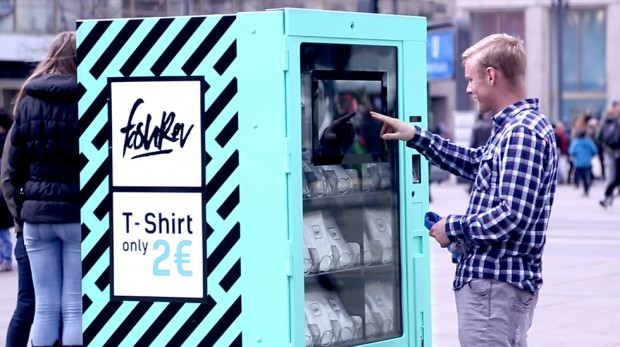
Friday, April 24, was Fashion Revolution Day, held in memory of the 1,129 workers killed in 2013 when the RanaPlaza garment factory in Bangladesh collapsed. As part of a social experiment conducted by Fashion Revolution in collaboration with the German BBDO agency, a bright turquoise vending machine, offering t-shirts for 2 Euros, was placed at the Alexanderplatz in Berlin, to test whether people would purchase upon being confronted with the conditions in which it was produced. It quickly went viral on You-Tube with over 6,000,000 hits. BOB GORDON chats to Perth’s Jessica Witt, a Junior Art Director at BBDO, who was involved in the production.
Describe the original brief then the creative process that followed.
Our brief was to spark discussion about how our clothes are made and raise awareness for Fashion Revolution Day. The most important part of our creative process was to be informed. We tried as much as possible to understand where the veil had been pulled, how much was concealed and did consumers care.
Upon realising and confirming the concept, what were the biggest challenges when it came to production?
Timing. As always is the case. However, we worked with Unit 9 in Berlin who took care of logistics, resourcing and production of the vending machine. From the creative perspective, our difficulty lay in delivering a complex issue to an unsuspecting consumer. The balance between simplifying the issue too much and keeping the consumer’s attention was easy to tip.
Describe the shoot. It must have been monumental.
We began at 8am at Alexanderplatz, Berlin to set up the vending machine and the hidden cameras. The most exciting part of the experiment was not knowing exactly what results we would get – of course we knew what we hoped for. As the experiment progressed it became apparent that if people are given the choice, they would rather buy clothes made in ethical conditions. That was encouraging to see.
You must have known that it would be a provocative video, but were you prepared for the ensuing reaction?
The response online was what we hoped for and more; the video proved a catalyst for productive discussion and awareness.
What have been the best outcomes in terms of reaction?
The best outcome was that people empathised with the campaign and acknowledged the immediate need for change. The message went viral within the week and was endorsed by celebrities and organisations. Most importantly, people used the video to discuss and speak directly to brands, and the brands responded.
And the worst? I’ve read knee jerk reactions claiming that it’s shame-marketing.
The intention of the experiment was not to shame anyone but to connect the consumers to the people making their clothes. The worst outcome would be if we did not acknowledge the individuals subjected to dangerous working conditions in order to meet the demands of the fast fashion industry.
Is it more important for fashion buyers or the mainstream fashion industry to take note?
Both play a powerful role in shaping the future of the fashion industry supply chain. Change can only truly occur if companies take responsibility for their methods of production. As consumers, the solution is not to boycott clothes produced in sweatshops, but start asking who made our clothes and putting pressure on larger companies to act.
For more information head to fashionrevolution.org.